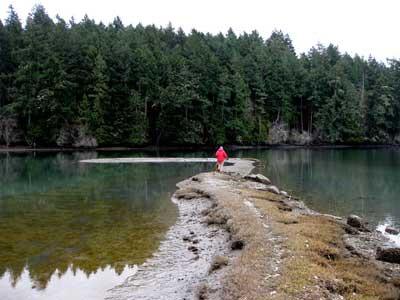By Steve Wehrly/Journal reporter
English Camp is growing, and may grow more.
The National Park Service acquired 34 acres of the former Westcott Bay Sea Farms property from the Conservation Fund for about $2.5 million and is seeking to acquire 36 additional acres for $400,000 when funding can be arranged.
The land has been owned since the 1960’s by the Webb family. Bill and Doree Webb purchased the property from Roche Harbor’s Tarte Family, and for a few years operated a private summer camp for boys on the site.
The Webb family operated an oyster farming and marketing business on the property for more than 30 years. The present conservation plans provide for continuing operation of the oyster business on the leased tidelands and about five waterfront acres that are not part of the transaction.
“The National Park Service was looking for a way to add valuable land to the park without compromising the ability of the oyster farm to operate and we’re pleased that we will be able to achieve both goals here,” said San Juan Island National Historical Park Superintendent Lee Taylor. “The beautiful property will be a wonderful addition to the national historical park and will provide real benefits to the community.”
The acquired land includes about a half-mile of Westcott Bay’s south shore and will be added to English Camp. The 11 shoreline acres adjoining the present English Camp provide rare beach access in the bay, especially at low tide, and account for much of the differential in price between the two main parcels.
Mark Elsbree of the Conservation Fund, a nationally renowned preservation-minded non-profit that offers financing for land acquisitions, which provided interim bridge funding for this project and for the $3 million acquisition by NPS of more than 320 acres on nearby Mitchell Hill, is pleased with his organization’s involvement.
“The amount of open space available to the public is limited on the island,” Elsbree said, “and the addition of the Webb property will further allow the Park Service to preserve and enhance the outstanding historical, natural and
recreational resources offered at San Juan Island NHP.”
The National Park Service has identified funding for initial overall planning for the land and for construction of an educational camp, and is working with volunteer organizations to begin trail refurbishment and clean-up projects. An extensive public process will precede major projects, according to Superintendent Taylor, but she is already pursuing “mechanisms through which we can request funds for specific projects.”
Some of the projects being considered are additional hiking trails – a trail connecting the Bell Point Trail at English Camp along the waterfront to the new property, and one connecting with the major island trailhead at the intersection of West Valley and Roche Harbor roads. The education camp already being planned might include tent pads, a kitchen facility, and rest rooms. A kayak and canoe launch, overnight camping and a facility for group events are listed as “potential” by the NPS.
The NPS acquired the first part of the 70-acre property from the Conservation Fund with funding from appropriations to the federal Land and Water Conservation Fund, a federal land protection program funded from offshore oil and gas royalties.
San Juan Island National Historical Park was established in 1966 by Congress with prodding by Sen. Henry (Scoop) Jackson. The Webb property – along with Roche Harbor proper – was part of a military reserve charted by Captain George E. Pickett of the U.S. Army and Captain George Bazalgette of the British Royal Marines in 1860, at the beginning of the boundary dispute finally resolved in 1872.
That military reserve is now the 900-acre English Camp at the north end of San Juan Island, which is paired with the 1,200-acre American Camp at the island’s southern end.



